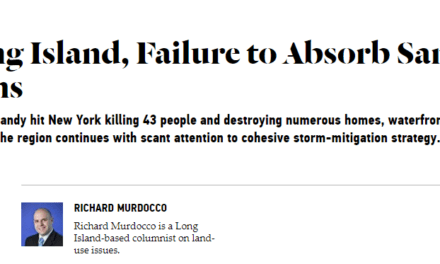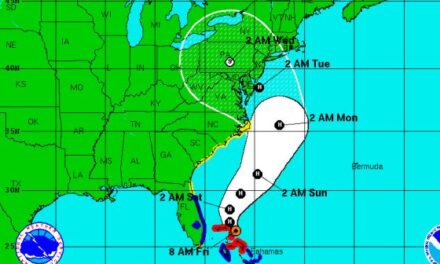The following was written exclusively for The Foggiest Idea, and published on June 12, 2017.
With each flush of the toilet in Suffolk County, the quality of Long Island’s water supply seems to go further down the drain.
For our 21st century suburbs, the statistics are staggering. Roughly 360,000 homes, or 75 percent of the county’s housing units, lack proper wastewater treatment. As the evidence has shown, the problem is only getting worse. Visible harmful algal blooms have closed shellfisheries, bays and beaches from Northport Harbor to the Hamptons.
The simple truth is that Long Island has an environmental capacity—it can only handle so much development—and yet we continue to build as if it does not.
Recently Suffolk County Executive Steve Bellone has been pushing an initiative that would give homeowners some financial backing for the installation of advanced septic systems through a series of private/public grants. According to the county, the new systems would cost around $18,000 each but the homeowner could get up to $10,000 in assistance to offset the expense. At present funding levels, only a fraction of Suffolk’s homes would even be in line to benefit from the preliminary program.
It’s certainly a step in the right direction, but will even this program be enough to win Bellone’s declared “war on nitrogen,” which seeks to combat rising levels of the pollution-causing element in our region’s drinking and surface waters?
A wholesale investment in sewers is needed to fully eradicate our region’s wastewater woes. But various estimates say doing that would cost billions of dollars. Aside from a marked lack of public funds for such an ambitious project, this monumental undertaking would also require a collective political will that just isn’t there to see it through—at least not now.
While Bellone’s program is a stopgap measure, it begins to address the larger issue at hand. Many of our pre-existing neighborhoods were built in such a pro-growth frenzy that builders in some cases didn’t even put in curbs or street lights yet alone think of proper sewage systems. As a result, the lack of infrastructure is essentially poisoning our drinking water supply slowly but surely.
The need to retrofit Long Island homes, especially in vulnerable communities along the coast, was proven in the Long Island Regional Planning Board’s 208 Study conducted in 1978, which highlighted the linkage between land use in a quickly suburbanizing area and its impacts on the region’s underground aquifers.
These days, it seems to be a daily occurrence to see alarming headlines in Newsday bringing attention to another harmful substance found in our groundwaters, such as the recent discovery of the contaminant 1,4-dioxane, toxic algal blooms that can harm both wildlife and humans, as well as routine beach closures after heavy rainfall because of surface water runoff.
Suffolk County has avoided the topic since the last big push to put sewers in Suffolk resulted in the costly Southwest Sewer District disgrace in the 1970s. As veteran journalist Karl Grossman recalled in a 2015 op-ed for the Southampton Press, “In a county long riddled with corruption, it became one of Suffolk’s biggest scandals. There were indictments and convictions.”
These days, sewering is seriously being considered, especially as the developmental pipeline in Nassau and Suffolk Counties is rife with large multifamily projects, all with their own wastewater options. Simply put, when sewers are built, buildings can become bigger, a fact that developers and elected officials know all too well.
While sewers are often touted as a panacea, it’s important to remember that they aren’t a “silver-bullet” solution. They come complete with their own environmental consequences, including lower water tables and dried up rivers, lakes and streams. Aside from that impact, some waste-water treatment plants continue to discharge treated waste back into the aquifer. Although innovative “grey-water” solutions exist, they are mere mitigation measures. They don’t address the growing problem at hand.
That’s why we can’t afford to forget all that the 208 Study advocated. It didn’t only argue for sewering in strategic locations, but it also called for the creation of innovative land-use policies to protect open space in geologically sensitive areas. With that spirit, subsequent planning efforts by Suffolk County in the 1980s and ’90s aimed to put the study’s recommendations into practice. The crowning achievement was the preservation of 150,000 acres of the Long Island Pine Barrens.
Now, as open space dwindles, some officials apparently believe that the easier way to address our serious water quality issues is with spot infrastructure improvements and smarter building.
Of course, there are no easy solutions. But it must remain a priority. Because with every new home and multifamily project that gets built, regardless of sewering, our water quality continues to decline.
The shame is that we won’t truly know what all the impacts of these developments are until decades from now—and hopefully by then it won’t be too late.
Richard Murdocco regularly writes and speaks on Long Island’s real estate development issues. He is the founder and publisher of The Foggiest Idea, an award-winning public resource for land use in the New York metro region. More of his views can be found on www.TheFoggiestIdea.org or follow him on Twitter @TheFoggiestIdea.
You can email Murdocco at Rich@TheFoggiestIdea.org.














Dear Mr. Murdocco, in the past I have written comments on your articles and op-eds wherein I stated that Long Island was being overdeveloped and your response to me, at that time, was that it was simply a matter of “smart” development and planning. Well, I now hear a different tenor in your voice. Have you concluded that the developers are now destroying Long Island at an alarming rate? Or do you still believe there is room for “smart” planning? I don’t. And as we all know, the preservation of the Pine Barrens is, most likely, to protect the land of the wealthy Long Islanders who don’t want their estates encroached upon by the very same developers (most likely the wealthy Long Islanders themselves!). Nassau is saturated to the point of suicide and extinction and Suffolk is only a hop, skip and a jump away. It is only a matter of time before Long Island becomes unlivable and without potable water.